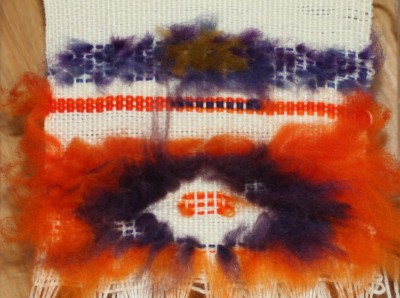Here’s the beginning of my rigid heddle sampler:

Here I was playing with materials (unspun wool roving), textures (furry vs. fuzzy vs. smooth), and a little bit with color (orange/purple and yellow/purple).
Like much of my work, the purpose of this sample isn’t to be a finished work, but an exploration of materials and ideas – taking a concept and playing with it, developing it into something that can be used in a later piece. What I plan to ask students to do is to select some materials and just play with them – not trying to make a finished piece, not worrying about whether it will work or not. Just playing with ideas and what-ifs.
At the end of the exploration period, I’ll ask the students to write down thoughts about their explorations – what they liked, what didn’t, how they could improve the parts that they didn’t like, and how they might use some of the things they explored in actual pieces.
For this example, my notes went something like this:
What I explored:
- Using unspun roving as a supplementary weft
- Furry, fuzzy, and smooth textures in a single piece
- Color combinations – orange/purple/white and yellow/purple/white
How to reproduce it:
- Rigid heddle loom, 8 -dent reed
- Kona Superwash yarn, natural, for warp and weft, ~1000 ypp
- Tufts of unspun roving embedded under three warp threads, with the furry ends sticking out. Roving is inserted every second pick, and beaten in along with the primary weft. (One pick primary weft + roving, one pick primary weft.)
What I liked:
- Furry texture is delightful to the fingers and to the eye – looks like soft clouds
- Fuzzy (trimmed) texture looks like pile rug but probably a lot faster to make
- Contrast in textures adds interest to the piece – it’s not just flat
- Orange and purple colors really pop each other – beautiful energy in the piece
What I didn’t like:
- The bottom sample is probably impossible to wash without losing the fuzzy effect. It would also felt immediately if subjected to abrasion. Thus, it’s only suitable for a wall hanging or some other art piece that will not be handled roughly or washed. The top sample may be similarly delicate – might be worth an experiment to see.
- Not very durable construction
- Fuzzy texture blurs details of design
- That orange and with that purple is a little too garish
- Yellow and purple doesn’t work at all – looks awful, in fact.
Ideas this brings up:
- use roving as fur in the depiction of an animal, or as fog in a landscape
- a piece with lots of textural contrast
- a wall hanging, simple geometric shapes with bright colors – showing off the differences in textures between the various lengths of “pile”.
- a piece with fairly large scale, so the fuzziness doesn’t obscure all the details.
- use roving “fur” to emphasize design details by adding contrast in texture
The idea of the exercise is to take time to play, and see where that takes you – so often we get focused on a specific project, and forget to explore!

playing with yarns knotted for cut pile is fun on the rigid heddle loom also – especially in a sampler.
so, exploring the fuzzy with roving and comparing it to the fuzzy with knots could be a great exercise.
You could finesse the felting issue by using superwash roving. I know that, at the very least, you can get SW Merino and SW BFL. These are principally meant to be spun into sock yarn, but why not explore their SW characteristics in other applications?